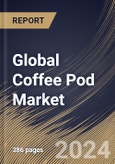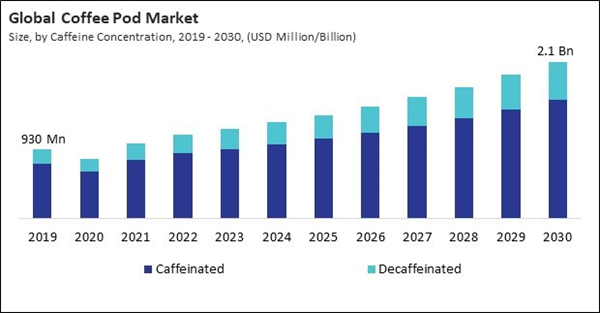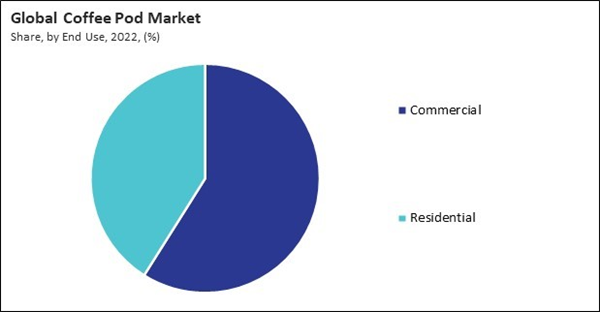The Global Coffee Pod Market size is expected to reach $2.1 billion by 2030, rising at a market growth of 8.3% CAGR during the forecast period. In the year 2022, the market attained a volume of 1,31654.25 thousand units, experiencing a growth of 7.9% (2019-2022).
European consumers are known for their appreciation of high-quality coffee. Therefore, the Europe segment captured $401.01 million revenue in the market in 2022. Europe has historically been a significant market for coffee consumption. The market has seen substantial growth in recent years due to the convenience and variety pods offer. Preferences for specific coffee blends, flavors, or specialty options may shape the market in Europe. Thus, these factors will boost the demand in the segment.
The pod manufacturers often introduce gourmet and specialty coffee options, providing consumers diverse flavors. From rich and bold roasts to lighter and more nuanced options, the variety allows individuals to choose coffees that align with their tastes. Manufacturers can quickly respond to market preferences, whether the popularity of certain flavor profiles or the introduction of innovative blends. Hence, there will be increased demand for these pods in the coming years.
Additionally, rising enterprise numbers and coffee culture in workplaces is beneficial for market. For instance, as per the data from Statistics Canada, small- and medium-sized businesses contribute significantly to the Canadian economy, making up 98.1% of all employer businesses in Canada in 2021. Small businesses employ 9.7 million individuals in Canada. Therefore, owing to these aspects, there will be enhanced growth in the market.
However, Consumers, especially in price-conscious segments, may perceive pod systems and premium coffee varieties as expensive compared to traditional brewing methods or standard coffee options. Effective product differentiation, whether through unique flavor profiles, convenience features, or sustainability aspects, can help mitigate price sensitivity concerns. Thus, these factors can limit the expansion of the market.
European consumers are known for their appreciation of high-quality coffee. Therefore, the Europe segment captured $401.01 million revenue in the market in 2022. Europe has historically been a significant market for coffee consumption. The market has seen substantial growth in recent years due to the convenience and variety pods offer. Preferences for specific coffee blends, flavors, or specialty options may shape the market in Europe. Thus, these factors will boost the demand in the segment.
The pod manufacturers often introduce gourmet and specialty coffee options, providing consumers diverse flavors. From rich and bold roasts to lighter and more nuanced options, the variety allows individuals to choose coffees that align with their tastes. Manufacturers can quickly respond to market preferences, whether the popularity of certain flavor profiles or the introduction of innovative blends. Hence, there will be increased demand for these pods in the coming years.
Additionally, rising enterprise numbers and coffee culture in workplaces is beneficial for market. For instance, as per the data from Statistics Canada, small- and medium-sized businesses contribute significantly to the Canadian economy, making up 98.1% of all employer businesses in Canada in 2021. Small businesses employ 9.7 million individuals in Canada. Therefore, owing to these aspects, there will be enhanced growth in the market.
However, Consumers, especially in price-conscious segments, may perceive pod systems and premium coffee varieties as expensive compared to traditional brewing methods or standard coffee options. Effective product differentiation, whether through unique flavor profiles, convenience features, or sustainability aspects, can help mitigate price sensitivity concerns. Thus, these factors can limit the expansion of the market.
By Caffeine Concentration Analysis
Based on caffeine concentration, the market is segmented into caffeinated and decaffeinated. In 2022, the decaffeinated segment garnered a 22.38% revenue share in the market. The decaffeinated segment is driven by consumers prioritizing health and lifestyle choices that involve reducing or eliminating caffeine consumption. Individuals sensitive to caffeine, pregnant women, and those looking to enjoy coffee later in the day without disrupting sleep often opt for decaffeinated pods.By End Use Analysis
On the basis of end use, the market is divided into commercial and residential. In 2022, the commercial segment witnessed the 58.95% revenue share in the market. Many offices have embraced pods as a convenient and efficient way to provide employees with quality coffee. These machines are often placed in break rooms or communal areas, allowing employees to enjoy a quick and customizable coffee experience without requiring extensive training or equipment.By Flavor Analysis
On the basis of flavor, the market is divided into caramel, chocolate, hazelnut, and others. The caramel segment recorded a 19.66% revenue share in the market in 2022. Caramel-flavored pods are characterized by their sweet and buttery notes, offering a delightful combination of sweetness and richness. The flavor profile appeals to consumers who enjoy a more indulgent and dessert-like coffee experience. Manufacturers often experiment with different coffee bean origins and roast levels to create unique caramel-infused profiles.By Distribution Channel Analysis
Based on distribution channel, the market is divided into hypermarkets & supermarkets, specialty stores, online channel, and others. The hypermarkets and supermarkets segment recorded a 35.1% revenue share in the coffee in 2022. Hypermarkets and supermarkets are known for offering various brands, flavors, and blends. Consumers who frequent these sizable stores are presented with an extensive assortment of coffee capsule products, ranging from renowned brands to niche and specialty varieties.By Regional Analysis
By region, the market is segmented into North America, Europe, Asia Pacific, and LAMEA. The North America segment procured a 30.43% revenue share in the market in 2022. North America boasts a robust and mature market driven by a large consumer base with a strong affinity for coffee consumption. The market has experienced consistent growth fueled by convenience, on-the-go lifestyles, and the desire for diverse coffee options.List of Key Companies Profiled
- illycaffè S.p.A. (Gruppo illy Spa)
- LUIGI LAVAZZA S.p.A.
- Gruppo Gimoka S.p.A.
- Blasercafé AG
- Gruppo Izzo S.r.l.
- Kimbo S.p.A.
- Segafredo Zanetti S.p.A. (Massimo Zanetti Beverage Group S.p.A)
- Procaffé S.p.A.
- Labcaffè Srl
- Caffe Borbone S.r.l.
Market Report Segmentation
By Caffeine Concentration (Volume, Thousand Units, USD Billion, 2019-2030)- Caffeinated
- Decaffeinated
- Commercial
- Residential
- Chocolate
- Hazelnut
- Caramel
- Others
- Hypermarkets & Supermarkets
- Online Channel
- Specialty Stores
- Others
- North America
- US
- Canada
- Mexico
- Rest of North America
- Europe
- Germany
- UK
- France
- Russia
- Spain
- Italy
- Rest of Europe
- Asia Pacific
- China
- Japan
- India
- South Korea
- Singapore
- Malaysia
- Rest of Asia Pacific
- LAMEA
- Brazil
- Argentina
- UAE
- Saudi Arabia
- South Africa
- Nigeria
- Rest of LAMEA
Table of Contents
Chapter 1. Market Scope & Methodology
Chapter 2. Market at a Glance
Chapter 3. Market Overview
Chapter 4. Global Coffee Pod Market by Caffeine Concentration
Chapter 5. Global Coffee Pod Market by End Use
Chapter 6. Global Coffee Pod Market by Flavor
Chapter 7. Global Coffee Pod Market by Distribution Channel
Chapter 8. Global Coffee Pod Market by Region
Chapter 9. Company Profiles
Companies Mentioned
- illycaffè S.p.A. (Gruppo illy Spa)
- LUIGI LAVAZZA S.p.A.
- Gruppo Gimoka S.p.A.
- Blasercafé AG
- Gruppo Izzo S.r.l.
- Kimbo S.p.A.
- Segafredo Zanetti S.p.A. (Massimo Zanetti Beverage Group S.p.A)
- Procaffé S.p.A.
- Labcaffè Srl
- Caffe Borbone S.r.l.
Methodology

LOADING...










